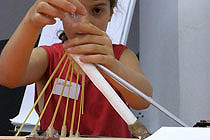
|
Workshops for Ground School Level Duration: 2 hours Admission price: includes learning programme, for school groups Euro 3.50 per head Information / reservations: Architekturzentrum Wien, 01-522 3115, office@azw.at Groups do not exceed 15 participants. Reservations: 01-522 31 15 or office@azw.at Building with Earth Clay Are clay and earth building materials from the middle-ages? How do you build with clay and earth, and is the material even weatherproof? There are many questions about this raw material, which is being used increasingly by architects and clients. Our expert Barbara Winklehner went to Africa to see how it's done, and introduces us to this fascinating material's possibilities. Then we build with clay. Building with Wood Can architects build with wood in Vienna? And why should people do it? Can a skyscraper be built of wood? What is important when building with wood? And don't wooden houses catch fire very easily? Our experts show us all the things you can do with wood. This is followed by experiments for us to do ourselves. [RE]BUILDING VIENNA In Vienna we are surrounded by architecture, by a built environment. Between home and school we pass familiar places, which we define with our actions. But how did Vienna, our hometown, develop and grow? The places we know so well, the shopping streets and buildings? The roads we drive along? What are their functions? A large number of architects have designed and dominated the way Vienna looks today. How did the Vienna of now develop from Vindobona? Together we explore and develop various ways to study the urban fabric. HOW DO ANIMALS LIVE? A housing shortage on the floor of the ocean, a subterranean living room, a bedroom in the middle of a river or with their home on their backs: animals live in places that are too damp, too cold or too windy for people. In the workshop space we give a free reign to our own ideas for housing. BRIDGING THE GAP Bridges dominate the face of our countryside and the towns and cities. They are an essential element of the built environment. We think about bridges with particularly daring constructions. We look back at reports in the media on what is currently the longest bridge in the world, or structural masterpieces in the bridge-building world. Bridges can be associated with purely functional practical structures like motorway bridges, for example, which are designed to overcome obstacles. What are the different types of construction, different shapes and functions, but also the social connections, associated with bridges? Kids engage playfully with the different types of bridge constructions. The rules of statics are explained with practical exercises showing how load is spread and tension works. ARCHIMATICS There are geometric shapes to be found wherever you look. But in which buildings are they concealed? What is the golden section, and what does it have to do with architecture? And, what's the difference between a 1:100 model and a 1:1 model? Is everything just a question of scale? Following an introduction to the maths involved we emerge ourselves in 'a_show' and the world of architecture. w3. HOW DO WE LIVE? This workshop is on the topic of Housing, with a focus on the discussion of types of floor plan and different forms of housing. The differences are analysed between the single-family house, terrace house, apartment building or high-rise housing, as well as the things that influence us when looking for a home and new building materials used in housing. In the practical exercise we are beamed into the year 3333 and have to develop a spacey model dwelling. Everyone decides for themselves whether in the future they want to live in outer space, on Mars or somewhere else. So the models will all be very different. Please bring a camera! NO LIMITS — Breaking Boundaries Boundaries and restrictions are manifested in our everyday lives by barriers, fences, spaces and even laws of nature or of the state. What are these boundaries for? Which ones can we dismantle, which ones have to be overcome? Boundaries as protection: The skin serves us well as the boundary of our body but it cannot protect us from cold or wind. With practical exercises we experience our own physical boundaries. Boundaries as the norm: Who are our buildings built for? Are they available for anybody to use or are certain people excluded from doing so? When, for instance, does a stairwell become a boundary? We test this out as a group together. In the practical part of the workshop we go forward to the year 2317. The population is running out of space on the earth, new habitats have to be found. What are the new boundaries when we want to build homes on the ocean bed, for example, in outer space or under the ground. What do the skin, clothes and architecture protect us from then? We pursue this question while building in unknown atmospheres. FLOATING HOUSES Have you ever thought about living on the water? About moving ‒ always by water ‒ from city to city, along with your entire home? Together we look at the materials, structural properties and architecture of floating shelter. Stimulated by various examples of these housing islands we then build our own floating home. |
 |
|
© Az W |
|
Learning Offers for schools - City expeditions - Workshops for school groups - - Permanent Exhibition "a_show" - - Workshops for Ground School Level - - The Az W Goes To School - - The Profession of the Architect - Pre-Scientific Work Activities for Adults Kindergarten Archikids Holiday workshops Birthdays Barrier-Free German as a foreign language Cooperations Team Information: Lisa Kusebauch-Kaiser Tel.: +43 (1) 522 31 15 Fax: +43 (1) 522 31 17 Email: office@azw.at Anne Wübben Tel.: +43 (1) 522 31 15 - 29 Fax: +43 (1) 522 31 17 Email: wuebben@azw.at |
| © Architekturzentrum Wien 2024 |
||



